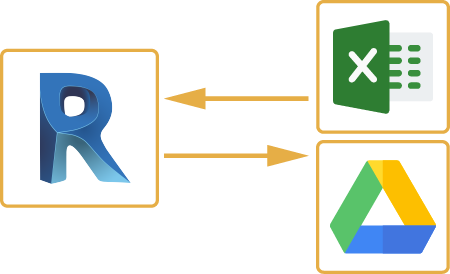Revit Accelerator: Excel Combination Strategies for Boosting Performance and Partnership
In this short article, we will certainly explore the advantages of integrating Excel right into your Revit workflows. And also, we will share finest techniques for flawlessly incorporating Excel into your Revit tasks. Get prepared to supercharge your Revit experience with our Revit Accelerator: Excel Assimilation Methods!
Advantages of Excel Integration in Revit
The advantages of Excel integration in Revit are many and can greatly improve performance and collaboration. By effortlessly connecting these two effective devices, you can streamline your workflow and conserve important time. With Excel combination, you can conveniently import and export data in between Revit and Excel, enabling you to utilize the staminas of both programs.

One more advantage of Excel assimilation is the capacity to create dynamic schedules and reports. By linking your Revit design to an Excel spread sheet, any kind of adjustments made in Revit will automatically update in the corresponding Excel data. This makes it simple to produce updated timetables, amount departures, and other project documentation.
Excel combination in Revit likewise allows much better partnership among employee. With the capability to import and export data, you can quickly share info with associates who may not have access to Revit. This advertises reliable interaction and permits far better control and decision-making.
Simplifying Operations With Revit and Excel
Enhancing operations with Revit and Excel can substantially boost performance and collaboration. By combining the capabilities of Revit and Excel, you can seamlessly transfer information in between the 2 applications, removing the demand for hand-operated information entrance and minimizing the danger of errors.
Using Revit and Excel together permits you to utilize the toughness of each program - revit tools. You can export data from Revit into Excel, where you can perform complex estimations, develop graphes and graphs, and examine the info in a more organized and efficient way. On the other hand, you can import information from Excel into Revit, enabling you to promptly update your models and documents based upon modifications made in Excel
The integration of Revit and Excel also promotes collaboration amongst team members. By sharing Excel documents, you can quickly communicate and team up on style and construction-related data. This boosts sychronisation and guarantees that everyone is functioning with the most current info.
Maximizing Cooperation With Excel and Revit
To optimize collaboration with Excel and Revit, you can flawlessly share and upgrade style and construction-related information with your team. By incorporating Excel with Revit, you can eliminate the requirement for hand-operated data access and reduce the danger of mistakes. With just a couple of clicks, you can import Excel spread sheets into your Revit version, allowing you to quickly accessibility and control the information. This integration allows you to team up much more successfully with your group, as everyone can deal with the very same data in real-time.
One of the crucial advantages of using Excel in conjunction with Revit is the capability to upgrade information in both programs at the same time. Any type of modifications made in Excel will instantly be mirrored in Revit, and vice versa. get redirected here This guarantees that everybody is working with the most updated info, staying clear of complication and conserving beneficial time.
Additionally, Excel provides powerful devices for analyzing and organizing data, which can considerably boost your cooperation initiatives. You can create customized records and charts in Excel, assisting you to imagine and communicate vital task details efficiently. This can be especially helpful when presenting data to stakeholders or making informed choices based upon job metrics.
Advanced Strategies for Enhancing Efficiency in Revit Utilizing Excel
By utilizing advanced techniques in Revit, you can significantly increase your performance by leveraging the power of Excel. Among the essential methods for increasing performance is by utilizing Excel as an information management tool. With Revit's Excel assimilation function, you can link Excel spread sheets directly to your Revit version, enabling you to easily take care of and update information. This combination enables you to produce schedules, compute quantities, and execute data analysis effectively.

Additionally, you can utilize Excel macros to automate recurring tasks in Revit (revit tool). Macros allow you to tape a collection of activities and play them back with a single click, his explanation saving you effort and time. You can create a macro to instantly generate room routines or upgrade criterion worths in mass.
Best Practices for Excel Integration in Revit
Using Excel as a data monitoring tool in Revit allows for reliable administration and updating of information. One of the best techniques for Excel combination in Revit is to create a clear and arranged data structure. By adhering to these best techniques, you can successfully utilize Excel as an information management device in Revit and increase your performance and cooperation.
Conclusion
In conclusion, integrating Excel with Revit can significantly boost performance and cooperation in the design process. By leveraging the power of Excel, Revit customers can achieve higher levels of productivity and collaboration in their projects.
With Excel integration, you can easily import and export data between Revit and Excel, allowing you to leverage the strengths of both programs.
One of the key advantages of Excel integration is the ability to use Excel solutions and features within Revit. By connecting your Revit version to an Excel spread sheet, any type of modifications made in Revit will immediately update in the corresponding Excel file. On the other hand, he has a good point you can import information from Excel right into Revit, enabling you to swiftly upgrade your models and documentation based on modifications made in Excel.
With Revit's Excel combination attribute, you can connect Excel spread sheets directly to your Revit model, allowing you to easily take care of and update information.